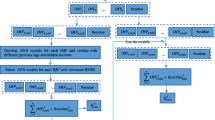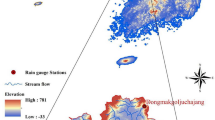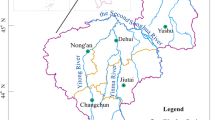Abstract
Thunderstorm frequency (TSF) prediction with higher accuracy is of great significance under climate extremes for reducing potential damages. However, TSF prediction has received little attention because a thunderstorm event is a combination of intricate and unique weather scenarios with high instability, making it difficult to predict. To close this gap, we proposed two novel hybrid machine learning models through hybridization of data pre-processing ensemble empirical mode decomposition (EEMD) with two state-of-arts models, namely artificial neural network (ANN), support vector machine for TSF prediction at three categories over Bangladesh. We have demarcated the yearly TSF datasets into three categories for the period 1981–2016 recorded at 28 sites; high (March–June), moderate (July–October), and low (November–February) TSF months. The performance of the proposed EEMD-ANN and EEMD-SVM hybrid models was compared with classical ANN, SVM, and autoregressive integrated moving average. EEMD-ANN and EEMD-SVM hybrid models showed 8.02–22.48% higher performance precision in terms of root mean square error compared to other models at high-, moderate-, and low-frequency categories. Eleven out of 21 input parameters were selected based on the random forest variable importance analysis. The sensitivity analysis results showed that each input parameter was positively contributed to building the best model of each category, and thunderstorm days are the most contributing parameters influencing TSF prediction. The proposed hybrid models outperformed the conventional models where EEMD-ANN is the most skillful for high TSF prediction, and EEMD-SVM is for moderate and low TSF prediction. The findings indicate the potential of hybridization of EEMD with the conventional models for improving prediction precision. The hybrid models developed in this work can be adopted for TSF prediction in Bangladesh as well as different parts of the world.









Similar content being viewed by others
References
Ahmed MK, Alam MS, Yousuf AHM, Islam MM (2017) A long-term trend in precipitation of different spatial regions of Bangladesh and its teleconnections with El Nino/southern oscillation and Indian Ocean dipole. Theor Appl Climatol 129(1–2):473–486. https://doi.org/10.1007/s00704-016-1765-2
Ali AF, Johari D, Ismail NFN, Musirin I, Hashim N (2011) Thunderstorm forecasting by using artificial neural network. In: 5th international power engineering and optimization conference, Shah Alam, Selangor, 2011, pp 369–374. https://doi.org/10.1109/PEOCO.2011.5970391
Alizadeh M, Alizadeh E, Asadollahpour Kotenaee S, Shahabi H, Beiranvand Pour A, Panahi M et al (2018) Social vulnerability assessment using artificial neural network (ANN) model for earthquake hazard in Tabriz city, Iran. Sustainability 10:3376. https://doi.org/10.3390/su10103376
Allen JT, Karoly DJ (2014) A climatology of Australian severe thunderstorm environments 1979–2011: inter-annual variability and ENSO influence. Int J Climatol 34:81–97. https://doi.org/10.1002/joc.3667
Allen JT, Tippett MK, Sobel AH (2015) An empirical model relating US monthly hail occurrence to large-scale meteorological environment. J Adv Model Earth Syst 7:226–243. https://doi.org/10.1002/2014MS000397
Boateng EB, Pillay M, Davis P (2019) Predicting the level of safety performance using an artificial neural network. In: Ahram T, Karwowski W, Taiar R (eds) Human systems engineering and design. Advances in intelligent systems and computing. Springer, Cham, pp 705–710
Boussabaine AH (1996) The use of artificial neural networks in construction management: a review. Constr Manag Econ 14(5):427–436. https://doi.org/10.1080/014461996373296
Bouttier F, Marchal H (2020) Probabilistic thunderstorm forecasting by blending multiple ensembles. Tellus A Dyn Meteorol Oceanogr 72(1):1–19. https://doi.org/10.1080/16000870.2019.1696142
Box G, Jenkins G (1970) Time series analysis: forecasting and control. Wiley, Hoboken
Breiman L (2001) Random forests. Mach Learn 45:5–32. https://doi.org/10.1023/A:1010933404324
Carrier C, Kalra A, Ahmad S (2013) Using paleo reconstructions to improve streamflow forecast lead time in the Western United States. JAWRA J Am Water Resour As 49(6):1351–1366. https://doi.org/10.1111/jawr.12088
Ch S, Anand N, Panigrahi BK, Mathur S (2013) Streamflow forecasting by SVM with quantum behaved particle swarm optimization. Neurocomputing 101:18–23. https://doi.org/10.1016/j.neucom.2012.07.017
Chen L, Letchford CW (2007) Numerical simulation of extreme winds from thunderstorm downbursts. J Wind Eng Ind Aerodyn 95(9–11):977–990. https://doi.org/10.1016/j.jweia.2007.01.021
Chen I, Hong J, Tsai Y, Fong C (2020) Improving afternoon thunderstorm prediction over Taiwan through 3DVAR-based radar and surface data assimilation. Weather Forecast 35(6):2603–2620. https://doi.org/10.1175/WAF-D-20-0037.1
Chen Y, Dong Z, Wang Y, Su J, Han Z, Zhou D, Zhang K, Zhao Y, Bao Y (2021) Short-term wind speed predicting framework based on EEMD-GA-LSTM method under large scaled wind history. Energy Convers Manage 227:113559. https://doi.org/10.1016/j.enconman.2020.113559
Chiogna G, Marcolini G, Liu W, Pérez Ciria T, Tuo Y (2018) Coupling hydrological modeling and support vector regression to model hydropeaking in alpine catchments. Sci Total Environ 633:220–229. https://doi.org/10.1016/j.scitotenv.2018.03.162
Collins W, Tissot P (2015) An artificial neural network model to predict thunderstorms within 400 km2 South Texas domains. Meteorol Appl 22:650–665. https://doi.org/10.1002/met.1499
Contreras J, Espinola R, Nogales FJ, Conejo AJ (2003) A.R.I.M.A. models to predict next-day electricity prices. IEEE Trans Power Syst 18(3):1014–1020. https://doi.org/10.1109/TPWRS.2002.804943
Czernecki B, Taszarek M, Kolendowicz L, Konarski J (2016) Relationship between human observations of thunderstorms and the PERUN lightning detection network in Poland. Atmos Res 167:118–128. https://doi.org/10.1016/j.atmosres.2015.08.003
Devak M, Dhanya C, Gosain A (2015) Dynamic coupling of support vector machine and K-nearest neighbour for downscaling daily rainfall. J Hydrol 525:286–301. https://doi.org/10.1016/j.jhydrol.2015.03.051
Dowdy AJ (2016) Seasonal forecasting of lightning and thunderstorm activity in tropical and temperate regions of the world. Sci Rep 6:20874. https://doi.org/10.1038/srep20874
Fan X, Zhang Y, Krehbiel PR, Zhang Y, Zheng D, Yao W, Xu L, Liu H, Lyu W (2020) Application of ensemble empirical mode decomposition in low-frequency lightning electric field signal analysis and lightning location. IEEE Trans Geosci Remote Sens 59:86–100. https://doi.org/10.1109/TGRS.2020.2991724
Gagne DJ, McGovern A, Haupt SE, Sobash RA, Williams JK, Xue M (2017) Storm-based probabilistic hail forecasting with machine learning applied to convection-allowing ensembles. Weather Forecast 32:1819–1840. https://doi.org/10.1175/WAF-D-17-0010.1
Gao J, Stensrud DJ (2014) Some observing system simulation experiments with a hybrid 3DEnVAR system for storm-scale radar data assimilation. Mon Weather Rev 142(9):3326–3346. https://doi.org/10.1175/MWR-D-14-00025.1
Ghimire S, Deo RC, Downs NJ, Raj N (2019) Global solar radiation prediction by ANN integrated with European Centre for medium range weather forecast fields in solar rich cites of Queensland Australia. J Clean Prod 216:288–310. https://doi.org/10.1016/j.jclepro.2019.01.158
Ghose B, Islam ARMT, Kamruzzaman M, Moniruzzaman M, Hu Z (2021) Climate-induced rice yield anomalies linked to large-scale atmospheric circulation in Bangladesh using multi-statistical modeling. Theoret Appl Climatol. https://doi.org/10.1007/s00704-021-03584-2
Glazer R, Torres-Alavez JA, Coppola E, Das S, Ashfaq M, Sines T (2020) Projected changes to severe thunderstorm environments as a result of 21st century warming from RegCM CORDEX-CORE simulations. EGU Gen Assem 2020:970
Gong Y, Wang Z, Xu G, Zhang Z (2018) A comparative study of groundwater level forecasting using data-driven models based on ensemble empirical mode decomposition. Water 10:730. https://doi.org/10.3390/w10060730
Haklander AJ, Delden AV (2003) Thunderstorm predictors and their forecast skill for the Netherlands. Atmos Res 67–68:273–299. https://doi.org/10.1016/S0169-8095(03)00056-5
Hawinkel P, Swinnen E, Lhermitte S, Verbist B, Van Orshoven J, Muys B (2015) A time series processing tool to extract climate-driven interannual vegetation dynamics using ensemble empirical mode decomposition (EEMD). Remote Sens Environ 169:375–389
Huang NE, Zheng S, Steven RL, Manli CW, Hsing HS, Quanan Z, Nai-Chyuan Y, Chi CT, Henry HL (1998) The empirical mode decomposition and the hilbert spectrum for nonlinear and non-stationary time series analysis. In :Proceedings mathematical, physical and engineering sciences vol 454, no 1971, pp 903–995. https://www.jstor.org/stable/53161
Huang S, Chang J, Huang Q, Chen Y (2014) Monthly streamflow prediction using modified EMD-based support vector machine. J Hydrol 511:764–775. https://doi.org/10.1016/j.jhydrol.2014.01.062
Islam ARMT, Nafiuzzaman M, Rifat J, Rahman MA, Chu R, Li M (2020) Spatiotemporal variations of thunderstorm frequency and its prediction over Bangladesh. Meteorol Atmos Phys. https://doi.org/10.1007/s00703-019-00720-6
Islam ARMT, Talukdar S, Mahato S et al (2021) Machine learning algorithm-based risk assessment of riparian wetlands in Padma River Basin of Northwest Bangladesh. Environ Sci Pollut Res. https://doi.org/10.1007/s11356-021-12806-z
Jacovides CP, Yonetani T (1990) An evaluation of stability indices for thunderstorm prediction in greater cyprus. Am Meteorol Soc 5(4):559–569. https://doi.org/10.1175/1520-0434(1990)005%3c0559:AEOSIF%3e2.0.CO;2
Johny K, Pai ML, Adarsh S (2020) Adaptive EEMD-ANN hybrid model for Indian summer monsoon rainfall forecasting. Theor Appl Climatol. https://doi.org/10.1007/s00704-020-03177-5
Kamangir H, Collins W, Tissot P, King SA (2020) A deep-learning model to predict thunderstorms within 400 km2 South Texas domains. Meteorol Appl. https://doi.org/10.1002/met.1905
Karlaftis MG, Vlahogianni EI (2011) Statistical methods versus neural networks in transportation research: differences, similarities and some insights. Transp Res C Emerg Technol 19(3):387–399. https://doi.org/10.1016/j.trc.2010.10.004
Kulikov MY, Belikovich MV, Skalyga NK, Shatalina MV, Dementyeva SO, Ryskin VG, Shvetsov AA, Krasil’nikov AA, Serov EA, Feigin AM (2020) Skills of thunderstorm prediction by convective indices over a metropolitan area: comparison of microwave and radiosonde data. Remote Sens 12:604. https://doi.org/10.3390/rs12040604
Lee JG, Ki-Hong Min KH, Park H, Kim Y, Chung CY, Chang EC (2020) Improvement of the rapid-development thunderstorm (RDT) algorithm for use with the GK2A satellite. Asia-Pac J Atmos Sci. https://doi.org/10.1007/s13143-020-00182-6
Litta AJ, Idicula SM, Mohanty UC (2013) Artificial neural network model in prediction of meteorological parameters during pre-monsoon thunderstorms. Int J Atmos Sci 2013:14. https://doi.org/10.1155/2013/525383
Liu Y, Wang R (2016) Study on network traffic forecast model of S.V.R. optimized by G.A.F.S.A. Chaos Solitons Fractals 89:153–159. https://doi.org/10.1016/j.chaos.2015.10.019
Mallick J, Talukder S, Islam ARMT, Shahfahad TNV (2021) Proposing receiver operating characteristic-based sensitivity analysis with introducing swarm optimized ensemble learning algorithms for groundwater potentiality modelling in Asir region, Saudi Arabia. Geocarto Int. https://doi.org/10.1080/10106049.2021.1878291
Mannan MA, Chowdhury MAM, Karmakar S, Ahmed S, Rahman A, Mondal MSH (2016) Prediction of heavy rainfall in association with severe thunderstorm in Bangladesh during pre-monsoon season. Atmos 6(1):64–76
Manzato A (2007) Sounding-derived indices for neural network based short-term thunderstorm and rainfall forecasts. Atmos Res 83:349–365. https://doi.org/10.1016/j.atmosres.2005.10.021
McGovern A, Elmore KL, Gagne DJ, Haupt SE, Karstens CD, Lagerquist R, Smith T, Williams JK (2017) Using artificial intelligence to improve real-time decision-making for high-impact weather. Bull Am Meteorol Soc 98:2073–2090. https://doi.org/10.1175/BAMS-D-16-0123.1
Meher JM, Das L (2019) Skill of CMIP5 climate models to reproduce the stability indices in identifying thunderstorms over the Gangetic West Bengal. Atmos Res 225:172–180. https://doi.org/10.1016/j.atmosres.2019.04.006
Meng E, Huang S, Huang Q, Fang W, Wu L, Wang L (2019) A robust method for non-stationary streamflow prediction based on improved EMD-SVM model. J Hydrol 568:462–478. https://doi.org/10.1016/j.jhydrol.2018.11.015
Mills GA, Colquhoun JR (1998) Objective prediction of severe thunderstorm environments: preliminary results linking a decision tree with an operational regional N.W.P. model. Weather Forecast 13:1078–1092. https://doi.org/10.1175/1520-0434(1998)013%3c1078:OPOSTE%3e2.0.CO;2
Napolitano G, Serinaldi F, See L (2011) Impact of EMD decomposition and random initialisation of weights in ANN hindcasting of daily stream flow series: an empirical examination. J Hydrol 406:199–214
Osuri KK, Nadimpalli R, Mohanty UC, Chen U, Rajeevan M, Niyogi D (2017) Improved prediction of severe thunderstorms over the Indian Monsoon region using high-resolution soil moisture and temperature initialization. Sci Rep 7:41377. https://doi.org/10.1038/srep41377
Pakalidou N, Karacosta P (2018) Study of very long-period extreme precipitation records in Thessaloniki, Greece. Atmos Res 208:106–115. https://doi.org/10.1016/j.atmosres.2017.07.029
Pham BT, Nguyen MD, Dao DV et al (2019) Development of artificial intelligence models for the prediction of compression coefficient of soil: an application of Monte Carlo sensitivity analysis. Sci Total Environ 679:172–184
Phuong NTB, Duy NB, Nghiem NC (2017) Remote sensing for monitoring surface water quality in the Vietnamese Mekong delta: the application for estimating chemical oxygen demand in river reaches in Binh Dai, Ben Tre. Vietnam J Earth Sci 39(3):256–268
Pradhan B, Lee S (2010) Landslide susceptibility assessment and factor effect analysis: backpropagation artificial neural networks and their comparison with frequency ratio and bivariate logistic regression modelling. Environ Model Softw 25:747–759. https://doi.org/10.1016/j.envsoft.2009.10.016
Qiu G, Wu Z, Li Z, Du Q (2010) Application of least square support vector machine for thunderstorm prediction. In: 8th world congress on intelligent control and automation, Jinan, pp 345–349. https://doi.org/10.1109/WCICA.2010.5555057
Rädler AT, Groenemeijer PH, Faust E, Sausen R, Púčik T (2019) Frequency of severe thunderstorms across Europe expected to increase in the 21st century due to rising instability. Clim Atmos Sci 2:30. https://doi.org/10.1038/s41612-019-0083-7
Rahman MS, Islam ARMT (2019) Are precipitation concentration and intensity changing in Bangladesh overtimes? Analysis of the possible causes of changes in precipitation systems. Sci Total Environ 690:370–387. https://doi.org/10.1016/j.scitotenv.2019.06.529
Rahman MS, Azad MAK, Hasanuzzaman M, Salam R, Islam ARMT, Rahman MM, Hoque MMM (2020) How air quality and COVID-19 transmission change under different lockdown scenarios? A case from Dhaka city, Bangladesh. Sci Total Environ. https://doi.org/10.1016/j.scitotenv.2020.143161
Saha TR, Quadir DA (2016) Variability and trends of annual and seasonal thunderstorm frequency over Bangladesh. Int J Climatol 36:4651–4666
Sahu RK, Dadich J, Tyagi B, Visa NK, Singh J (2020) Evaluating the impact of climate change in threshold values of thermodynamic indices during pre-monsoon thunderstorm season over Eastern India. Nat Hazards 102:1541–1569
Salam R, Islam ARMT (2020) Potential of RT, bagging and RS ensemble learning algorithms for reference evapotranspiration prediction using climatic data-limited humid region in Bangladesh. J Hydrol 590:125241. https://doi.org/10.1016/j.jhydrol.2020.125241
Shadab A, Ahmad S, Said S (2020) Spatial forecasting of solar radiation using A.R.I.M.A. model. Remote Sens Appl Soc Environ 20:100427. https://doi.org/10.1016/j.rsase.2020.100427
Siddiqui ZA, Rashid A (2008) Thunderstorm frequency over Pakistan. Pak J Meteorol 5:39–63
Solari G, Rainisio DD, Gaetano P (2017) Hybrid simulation of thunderstorm outflows and wind-excited response of structures. Meccanica 52:3197–3220. https://doi.org/10.1007/s11012-017-0718-x
Suparta W, Putro WS (2018) Parametric studies of ANFIS family capability for thunderstorm prediction. In: Suparta W, Abdullah M, Ismail M (eds) Space science and communication for sustainability. Springer, Singapore. https://doi.org/10.1007/978-981-10-6574-3_2
Tabrizi AA, Garibaldi L, Fasana A, Marchesiello S (2015) Performance improvement of ensemble empirical mode decomposition for roller bearings damage detection. Shock Vib 2015:10. https://doi.org/10.1155/2015/964805
Talukdar S, Eibek KU, Akhter S, Ziaul SK, Islam ARMT, Mallick J (2021) Modeling fragmentation probability of land-use and land-cover using the bagging, random forest and random subspace in the Teesta River Basin, Bangladesh. Ecol Ind 126:107612. https://doi.org/10.1016/j.ecolind.2021.107612
Tan QF, Lei XH, Wang X et al (2018) An adaptive middle and long-term runoff forecast model using EEMD-ANN hybrid approach. J Hydrol 567:767–780
Taszarek M, Allen J, Púčik T, Groenemeijer P, Czernecki B, Kolendowicz L, Lagouvardos K, Kotroni V, Schulz W (2019) A climatology of thunderstorms across Europe from a synthesis of multiple data sources. J Clim 32(6):1813–1837. https://doi.org/10.1175/JCLI-D-18-0372.1
Taylor KE (2001) Summarizing multiple aspects of model performance in a single diagram. J Geophys Res 106:7183–7192. https://doi.org/10.1029/2000JD900719
Trenberth KE, Jones PD, Ambenje P et al (2007) Observations: surface and atmospheric climate change. In: Solomon S, Qin D, Manning M, Chen Z, Marquis M, Averyt KB, Tignor M, Miller HL (eds) Climate change 2007: the physical science basis, chapter 3. Contribution of working group I to the fourth assessment report of the intergovernmental panel on climate change. Cambridge University Press, Cambridge, UK and New York
Umakanth N, Satyanarayana GC, Simon B, Rao MC, Babu NR (2020) Long-term analysis of thunderstorm-related parameters over Visakhapatnam and Machilipatnam, India. Acta Geophys. https://doi.org/10.1007/s11600-020-00431-2
Vapnik V (1995) The nature of statistical learning theory. Springer, New York. https://doi.org/10.1007/978-1-4757-3264-1
Vapnik V (1998) Statistical learning theory, vol 1. Wiley, New York
Vujović D, Paskota M, Todorović N, Vučković V (2015) Evaluation of the stability indices for the thunderstorm forecasting in the region of Belgrade, Serbia. Atmos Res 161–162:143–152. https://doi.org/10.1016/j.atmosres.2015.04.005
Wahiduzzaman M, Islam ARMT, Luo J, Shahid S, Uddin MJ, Shimul SM, Sattar MA (2020) Trends and variabilities of thunderstorm days over Bangladesh on the ENSO and IOD timescales. Atmosphere 11:1176. https://doi.org/10.3390/atmos11111176
Wang WC, Chau KW, Xu DM, Chen XY (2015a) Improving forecasting accuracy of annual runoff time series using ARIMA based on EEMD decomposition. Water Resour Manag 29:2655–2675
Wang J, Xu X, Meng X (2015b) The modified ensemble empirical mode decomposition method and extraction of oceanic internal wave from synthetic aperture radar image. J Shanghai Jiaotong Univ (Sci) 20(2):243–250. https://doi.org/10.1007/s12204-015-1614-y
Wu Z, Huang NE (2009) Ensemble empirical mode decomposition: a noise-assisted data analysis method. Adv Adapt Data Anal 1:1–41. https://doi.org/10.1142/S1793536909000047
Yasen M, Al-Jundi R, Al-Madi N (2017) Optimized ANN-ABC for thunderstorms prediction. IEEE, pp 98–103. https://doi.org/10.1109/ICTCS.2017.37
Yu M (2020) Short-term wind speed forecasting based on random forest model combining ensemble empirical mode decomposition and improved harmony search algorithm. Int J Gr Energy 17(5):332–348. https://doi.org/10.1080/15435075.2020.1731816
Zhang X, Liu Y, Yang M, Zhang T, Young A, Li X (2013) Comparative study of four time series methods in forecasting typhoid fever incidence in China. PLoS ONE 8(5):e63116. https://doi.org/10.1371/journal.pone.0063116
Zhang X, Peng Y, Zhang C, Wang B (2015) Are hybrid models integrated with data pre-processing techniques suitable for monthly streamflow forecasting? Some experiment evidences. J Hydrol 530:137–152
Zhen-hui W, Yi Z, Jia Z (2013) A preliminary study on thunderstorm forecast with LS-SVM method. J Trop Meteorol 19(1):104–108
Zhou Q, Jiang H, Wang J, Zhou J (2014) A hybrid model for PM2.5 forecasting based on ensemble empirical mode decomposition and a general regression neural network. Sci Total Environ 496:264–274. https://doi.org/10.1016/j.scitotenv.2014.07.051
Acknowledgements
We are grateful to the Department of Disaster Management, Begum Rokeya University, Rangpur, for all sorts of assistance provided during this study. Furthermore, we would like to thank the Bangladesh Meteorological Department (BMD) for providing the required data for this research.
Author information
Authors and Affiliations
Contributions
MAKA designed, conceptualized, drafted the original manuscript; ARMTI and MAKA planned the documents; MAKA and MSR were involved in statistical analysis; ARMTI and MAKA interpret the analysis; KA contributed to instrumental setup, data analysis, validation; MAKA, MSR, and KA contributed to data collection and extraction; MAKA and ARMTI edited the manuscript, literature review, discussion and also involved in software, mapping, and proofreading during the manuscript drafting stage.
Corresponding authors
Ethics declarations
Conflict of interest
The authors declared that they have no conflict of interest.
Additional information
Publisher’s Note
Springer Nature remains neutral with regard to jurisdictional claims in published maps and institutional affiliations.
Supplementary Information
Below is the link to the electronic supplementary material.
Rights and permissions
About this article
Cite this article
Azad, M.A.K., Islam, A.R.M.T., Rahman, M.S. et al. Development of novel hybrid machine learning models for monthly thunderstorm frequency prediction over Bangladesh. Nat Hazards 108, 1109–1135 (2021). https://doi.org/10.1007/s11069-021-04722-9
Received:
Accepted:
Published:
Issue Date:
DOI: https://doi.org/10.1007/s11069-021-04722-9




